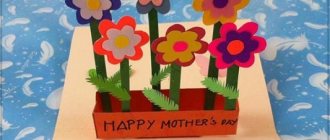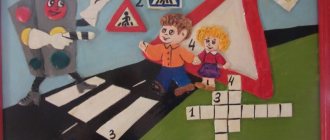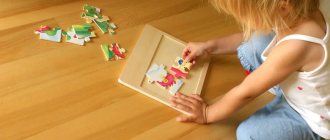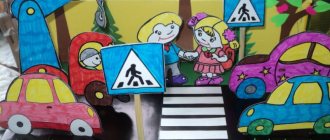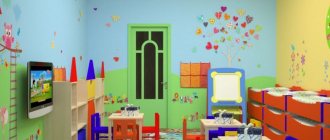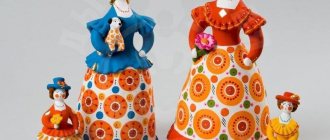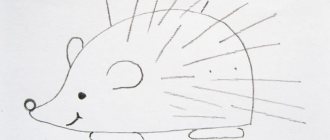Educational book with an individual character
A laptop is an educational folder dedicated to a specific topic. This manual is prepared at home and always with the help of a child. The secret of a lapbook is in its design: it is appropriate to use a variety of pockets, additional spreads, “windows” and other interesting design options. A laptop for preschoolers can contain not only a summary of basic knowledge on a chosen topic, but also additional logical and creative tasks. This “game” is perfect for viewing alone or studying with children. And what’s most important is that making a lapbook is not at all difficult, and this process is sure to captivate the whole family and give only positive emotions.
What is a lapbook?
The laptop is the latest invention for child development.
Translated from English it means “knee book”. The device is actively being introduced into the educational process for preschoolers and primary schoolchildren. In addition, the lapbook is very easy to make and is suitable for playing at home. This homemade mini book allows your child to quickly absorb the necessary material, consolidating acquired skills by rearranging, comparing, or searching for various details.
History of origin
For the first time, a similar folder was introduced into classes by a writer from Virginia, Temmie Dubey. She used the mini book to organize learning material for her children. The laptop is small in size and large in capacity.
The author of the invention improved the experience of Dina Zayk, who used folded sheets of paper with interactive tasks to teach children. Temmie placed various themed games in one folder, which made the process of learning the material more fun.
On a note! In Russia, a mathematics teacher was the first to start making laptops. Tatyana Pirozhenko is from Simferopol. She is a mother of 2 children and in her free time she develops new types of kneeling books, which are rapidly gaining popularity.
What is it needed for
This method of training is used for:
- Organization of a child’s cognitive activity.
- Interactions between adults and children.
- Development of attention.
- Formation of perseverance.
- Activation of the thought process.
- Development of creative abilities and imagination.
- Accustoming your baby to collective exercises.
- Formation of correct pronunciation and writing.
Important! The main task of a lapbook is to promote the intellectual enrichment of the child with subsequent memorization of the information already received.
Advantages of using knee books:
- Help in systematizing acquired skills.
- A convenient method for repeating covered material and better memorization thanks to associative thinking.
- The child learns to independently conduct analysis in a playful way.
- The kneeling book is suitable for exercises in kindergartens, schools and at home.
- The ability to produce various thematic contents inside the folder, selecting material based on the child’s abilities and previously acquired skills (individual approach).
Another important advantage is the simplicity and speed of making a lapbook. Even a child can do some types of interactive exercises without much time. A mini book can be made by teamwork or independently.
Kinds
There are a huge number of different lapbooks. They are usually divided into the following groups:
- Encyclopedic. The simplest type of mini folder. All the necessary information is in the encyclopedia. The main task is to distribute it correctly. It is enough to place 5-6 interactive tasks on a specific topic (water, space, animal, etc.). Such activities are suitable for school-age children.
- Plot. They are created based on your favorite books or cartoons. Often, after watching a cartoon, a child wants to play the plot over and over again, but watching it is no longer interesting. Invite him to create his own “world” with his favorite characters. Music folders with theater elements are also used for training.
- Thematic. They involve the introduction of various educational subjects with game elements into the lesson. Suitable for children in the middle and preparatory groups of kindergarten. With their help you can study:
- Seasons (autumn, winter, summer, spring).
- Animals.
- Vegetables and fruits.
- Constitution of man.
- Professions.
- Nature.
- Clock, etc.
Educators often develop laptops based on fairy tales to develop a child’s speech.
School
They are divided by subjects (mathematics, Russian language, ecology, fire safety, life safety, physics, chemistry). For each discipline, you can choose a specific topic for teaching your child.
Congratulations
Such folders are used as gifts for holidays (New Year, Birthday, Easter). Create a holiday mini book with your little one. Let him lead the process and make his wishes.
You can also invite your child to create an autobiographical story using a lapbook. Such kneeling books are usually made by the child himself. Photographs, pictures with wishes for the future, dreams, goals, etc. are attached to the base.
Materials and tools
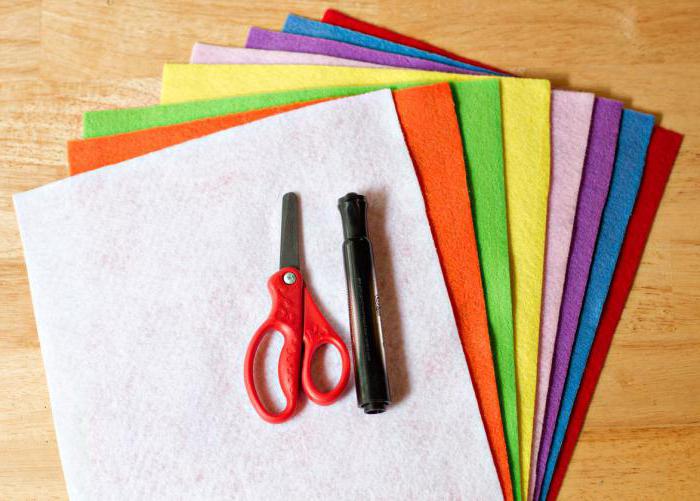
The most convenient way to make laptops is from cardboard document folders. But if you don’t have one on hand, you can choose a regular sheet of cardboard as a base. As for the interior design, there are two options: either you draw and glue everything by hand, or you cut out printouts made on a printer. Each of these options is good in its own way, in the first case the scope for imagination is unlimited, in the second you can complete all the work much faster. How to make a laptop for preschoolers using a computer and a printer? Templates can be prepared in any graphics program. We present to your attention a ready-made sample that you can also use in your work. And yet, if the child is large enough and independent, it is much more interesting to make lapbooks with your own hands, using only colored paper, cardboard and various decorative elements. And don’t be afraid to do something crookedly or not carefully enough; children, as a rule, do not pay attention to such little things and value handwork much more than adults, regardless of its quality.
Choosing a topic for a visual aid
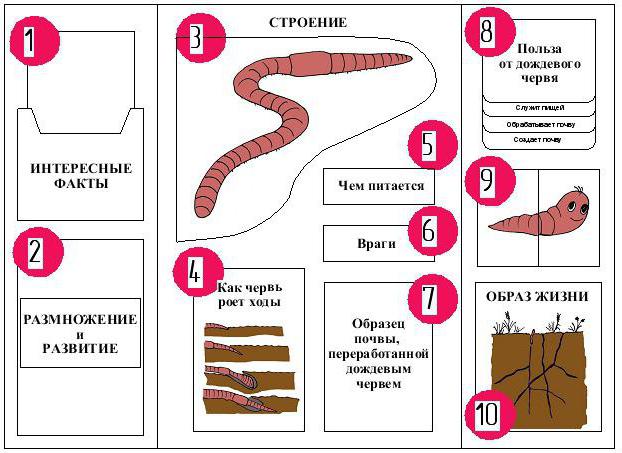
Are your creative materials ready and waiting in the wings? Great, it's time to decide what topic your first development folder will be devoted to. The advantage of this type of manual is that it can be devoted to absolutely any topic. You can collect in one folder a short summary about the flora and fauna of a forest or meadow, or dedicate such a visual summary to a specific profession. You can also make a lapbook based on fairy tales for preschoolers, about a specific animal or object. The possibilities of educational folders are almost limitless; make such a guide about the types of geometric shapes, the structure of the Universe, and the history of the state.
Middle group. Junior preschool age. Children 4 - 5 years old
Lapbook on ecology “Ecolyats - preschool children” for children 3–4 years old"
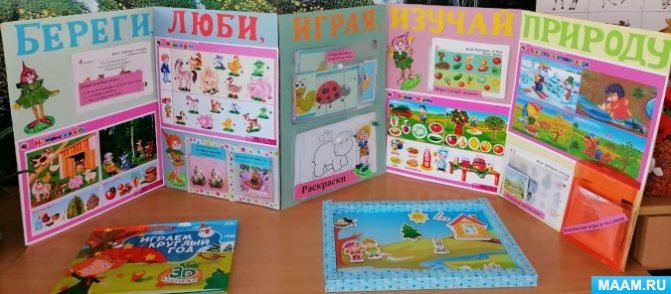
was made by Olga Vyacheslavovna Leonova, teacher of the MBDOU CRR kindergarten of the first category No. 59
“Gourmand”
for a visual and effective introduction to the nature of children of the second youngest group (3-4 years old. The purpose of
the lapbook : the formation in children ...
Lapbook “This is me and my family” in speech and social and communicative development for younger preschoolers
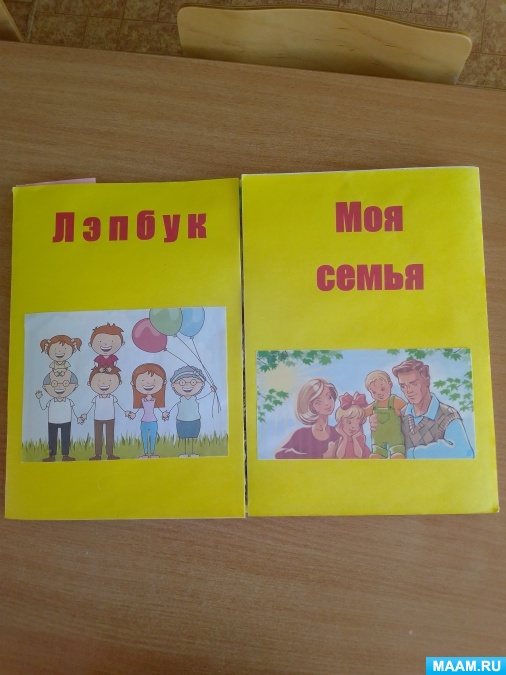
.
The basis of the laptop is created , supplemented and improved. A laptop is an excellent assistant in the work of educators. It can be used for both individual and…
Lapbook for preschoolers: master class with step-by-step instructions
Take a cardboard folder and cover its inner parts with colored paper or cardboard. Now is the time to start preparing the content for our laptop. It would be very good if there were general data inside in the form of a brief summary on the topic being studied, and assignments for independent work. For example, if you are making a lapbook on traffic rules for preschoolers, make cards with the most important rules and place them in a separate pocket. Prepare separate assignments - riddles on the chosen topic, some not too difficult tasks. The most convenient way is to place the cards in pockets glued to the base. You can also use other design options - fold a rectangular sheet like an accordion, make paper houses with opening windows, envelopes, use bulky double-sided tape to highlight individual elements. Don’t forget to decorate the cover too - you can glue a beautiful printout on it on the chosen topic, draw a picture or make an applique, and for kids who already know how to read, an “adult” book cover with a title is also suitable.
Description of the procedure for compiling a lapbook “Seasons”
Let us dwell on the intricacies of creating a manual for preschoolers of middle and older age.
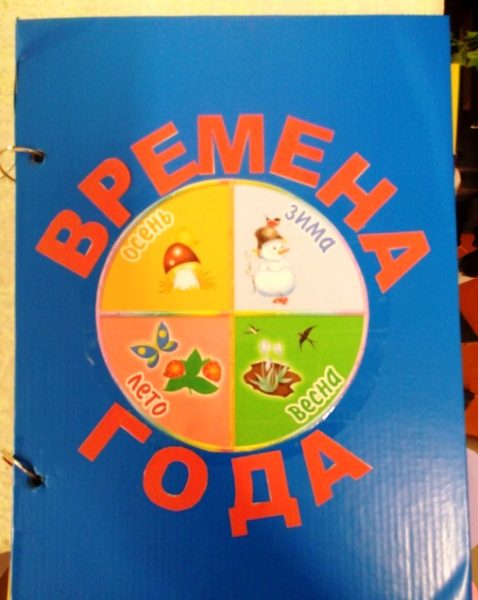
For the cover you can choose a picture depicting the main signs and symbols of each season
Materials and tools:
- 4 sheets of thick cardboard (can be from packaging of household appliances);
- self-adhesive in blue, yellow, green and red colors;
- scissors;
- hole puncher;
- ring holder for a binder (you can use rings with a cut - “jump rings” used in jewelry);
- colored cardboard for pockets and envelopes;
- pictures for designing the manual and printed names of pockets and envelopes.
Instructions:
- We trim the sheets so that they are of the same format.
- We paste one sheet on both sides with blue paper, and one sheet, also on both sides, with red paper. We paste the next sheet with blue paper on one side and yellow paper on the other, then make one side of the next sheet of cardboard yellow, the other green, then one side green, the other red.
- We assemble the pages so that the spread is one color, the cover pages are blue and red.
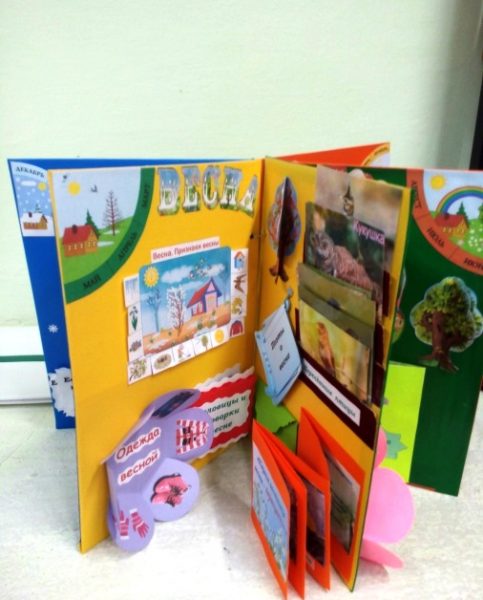
Each spread dedicated to a specific time of year has its own color.
We pierce the pages with a hole punch and insert rings.
We design the blue spread to match the winter theme. We make the pockets blue, for the game materials we make a snowman whose circles are accordion books with the rules of these games.
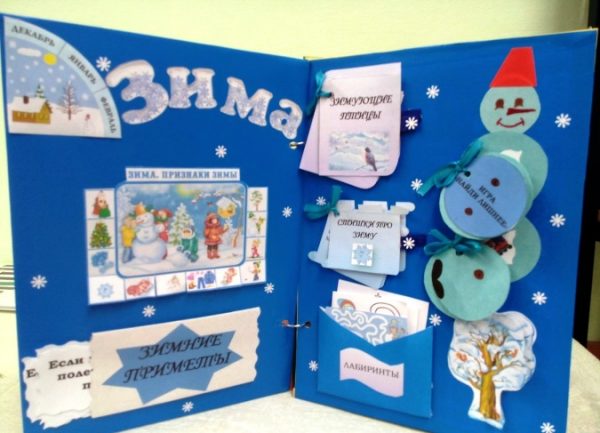
“Winter” pages can be decorated with decorative snowflakes
We decorate the yellow spread with envelopes and pockets.

For a “spring” spread, the pockets can be in the shape of flowers
On the summer spread we place envelopes in the shape of flowers, “doors” with a fairy tale and pockets with plot pictures.
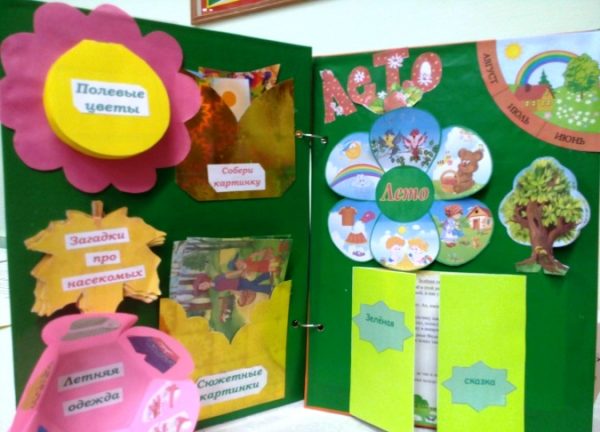
Curly envelopes in the form of flowers are also used in the design of the “summer” spread
We begin to design the autumn spread, placing “accordions” and pockets there.
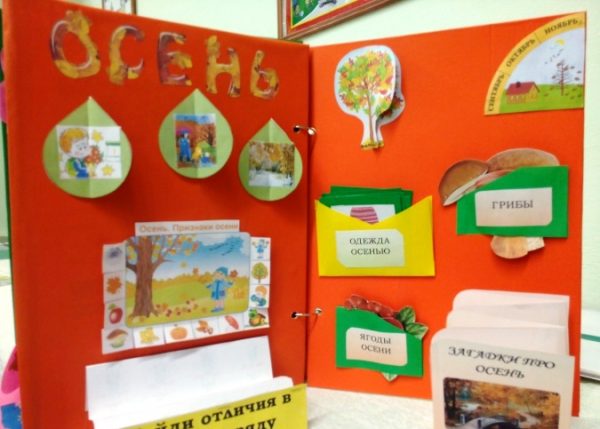
Thematic pictures about autumn can be made in small format and glued to a background in the form of droplets
Materials for the manual “Seasons”
Usually thematic lapbooks are compiled for all seasons separately, so this particular guide is in the nature of a generalization of the main signs of each season.
Block with text information
This section includes:
- general signs of each season;
- information about the months, their alternation, possibly with poems suitable for each month;
- a list of interesting folk signs for each season;
- fun facts for every season.
Block with poems and riddles
For children 3–4 years old, a block of poetry can be compiled based on the selection proposed here.
For older children, the selection can include poems by Russian classics. Moreover, they can be grouped by seasons and months.
As for riddles, when compiling the “Seasons” lapbook, the same rules apply as when developing manuals on other topics:
- riddles are included in the lapbook from the second youngest group;
- for children 3–4 years old, riddles should have rhyming answers.
For example, for kids the selection could be like this:
- I have a lot to do: I cover the whole earth with a white blanket, I whiten the fields, houses, My name is... (winter);
- I am made of heat. I carry the warmth with me. I warm the rivers, I invite you to swim. And you all love me for this. I... (summer);
- I open the buds, I dress the trees in green leaves. I water the crops, there is a lot of movement. My name is... (spring);
- I bring the harvests, I sow the fields again, I send the birds to the south, I strip the trees, But I don’t touch the pines and fir trees. I... (autumn).
For children in the middle and older groups, riddles can be more difficult to choose, for example, to illustrate each season:
- winters - They didn’t raise me - they made me out of snow. Instead of a nose, they cleverly inserted a carrot. Eyes are coals, hands are knots. Cold, big, who am I? (Snow Woman);
- spring - A beauty walks, touches the ground lightly, walks to the field, to the river, and on the snow and on the flower. (Spring);
- summer - the sun is shining, the linden tree is blooming. The rye ripens, when does this happen? (Summer);
- autumn - coins are falling from the trees from heavy rain and wind. I'll pick up ten coins and make a big bouquet. (Autumn leaves).
Block with themed games
This block is represented by tasks of different types of games.
Table: selection of games for the “Seasons” lapbook
| What is the name of the game | How to play it | What age children is it addressed to? |
| Didactic games | ||
| “What’s out of season?” | The teacher names the season and shows a picture of clothes. If the outfit is in season, the children clap, and if it is not in season, then they stomp. | For younger preschool age |
| "When it happens" | Children take one large picture depicting the season. The teacher shows one small one, the children determine when this happens. The winner is the one who collects four small pictures for his season faster. For older preschoolers, you can complicate the task: using the collected pictures, children make up a story. | For middle preschool age |
| "Collect a picture" | The guys put together pictures from the elements. | |
| Outdoor games | ||
| “Birds and Chicks” (with elements of imitation) |
| For younger, middle |
| "Snow Woman" |
| For middle and seniors |
| "Catch a mosquito" |
| For anyone |
| Finger game | ||
| "Months" | Winter months: December, January Let’s not forget to add February to them (arms are placed to the sides, imitating the fall of snowflakes) For spring we give March, April, warm May (arms raised above the head, imitating a light breeze) For summer - June, July, August, come on (hands in front of us, palms pressed to each other, imitating the “fish swims” movement) And if autumn comes to visit us, September, October, November will bring! (we imitate picking berries in a basket) | For younger preschoolers |
Sources
- https://rechudetey.ru/razvivayushhie-igry/lyepbuk.html
- https://nitforyou.com/lepbuk/
- https://sovets.net/15664-lepbuk.html
- https://lafoy.ru/lepbuk-svoimi-rukami-10-idey-501
- https://melkie.net/podborki/lepbuk-vremena-goda.html
Examples of filling
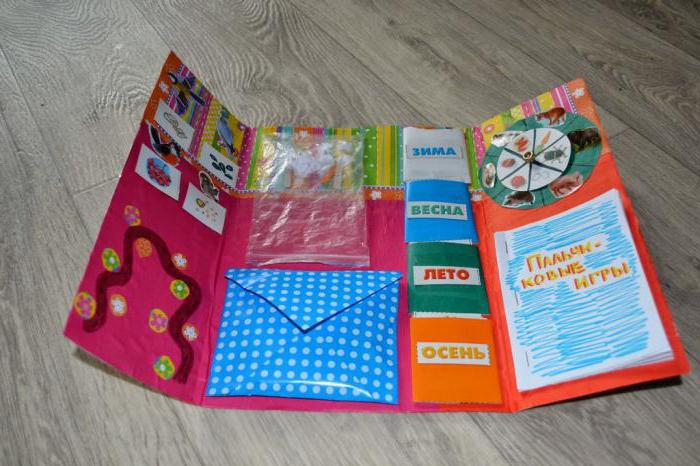
When you open a standard cardboard folder, you get two or three A4 sheets to fill. What kind of educational material should be placed on them? A laptop allows you to collect in one manual a wide variety of educational activities for preschoolers. For inspiration, you can look at board games and workbooks that your child already has. Depending on his age, these may be tasks such as “make a pair of two cards,” puzzles, elements for coloring, counting material, “find the differences.” Don’t forget about logic problems and riddles - offer your child short stories or rhymes, after listening to which you will need to give the correct answer. A laptop for preschoolers is also a colorful outline. Organize basic information on the chosen topic using diagrams and pictures, lists and signs.
Psychological mirror
In early preschool age, it is enough to form and expand children’s ideas about three basic emotions: joy, sadness, anger. I suggest making a Lapbook for this age. The basis can be taken from any of the proposed (What could be the basis) Games and exercises with the “Emotions” lapbook.
“Find the same emotions” (Sheet 4 and 5)
Goal: learn to compare emotions in pictures, find the same emotion, and name it. The circles are cut out, and “curtains” are placed on top. They should be located next to the cut out parts. Attach to the base so that the inside rotates.
“Cut pictures” (Sheet 2, 3, 7)
Goal: development of integrity of perception, recreating imagination. The set has 3 levels of complexity (2 parts, 3 parts, 4 parts). Cut the cards and place them in beehive pockets according to emotions.
“Bees and daisies”
Goal: learn to compare emotions in pictures, find the same emotion, and name it. The child needs to put a bee on a flower with the same emotion.
“Houses for bees.”
Goal: development of children’s perception, learning to compare the shape of an object. Return the bees to their houses, leaning on the shadow.
“Clouds”
Goal: learn to compare color with emotions. Children need to water the cloud with a color that matches the mood of the flower.
“Continue the row” (Sheet 8, 9, 10)
Goal: development of attention and thinking. You need to determine what emotion will come next.
“Remember and repeat”
Goal: development of visual and auditory memory. Remember and repeat a row of unfolding accordions or laid out independently from cut parts of sheet 8. To develop auditory memory, a row is dictated, the child picks it out after the entire row has been named. It's better to start with two or three objects. By the age of 4, these rows can reach 5 objects.
“Rain”
Goal: teaching the relationship between color and emotion, developing emotional perception. You need to water the daisies from a cloud of the corresponding color to the emotion.
“Big, medium, small”
Goal: development of size perception.
Daisies in three sizes. You can glue the medium-sized ones onto the background and lay out only the small, large ones, or you can sort all three sizes.
Assembly option No. 2.
Lapbook, instructions on how to assemble, buy, emotions, templates, download, free, junior group Lapbook, instructions on how to assemble, buy, emotions, templates, download, free, junior group Lapbook, instructions on how to assemble, buy, emotions, templates , download, free, junior group Lapbook, instructions, how to assemble, buy, emotions, templates, download, free, junior group
Lapbook materials
Lapbook, pocket, download, free, emotions Lapbook, pocket, download, free, emotions Lapbook, pocket, download, free, emotions Lapbook, pocket, download, free, emotions
Backgrounds and frames
We kindly ask you to write reviews when downloading! To download, right-click on the image and save. Or download the archive immediately: lapbook Emotions
Instructions for assembling Lapbooks on Emotions: download for free Instructions for assembling Lapbooks on Emotions on the website
Also on the site there is a Lapbook “Emotions” for children of the middle group, a Lapbook “Emotions” for children of senior preschool age, “The World of Emotions” for children of the preparatory group. More details
Lapbooks on other topics.
Views 1,351, Today 8
Design secrets
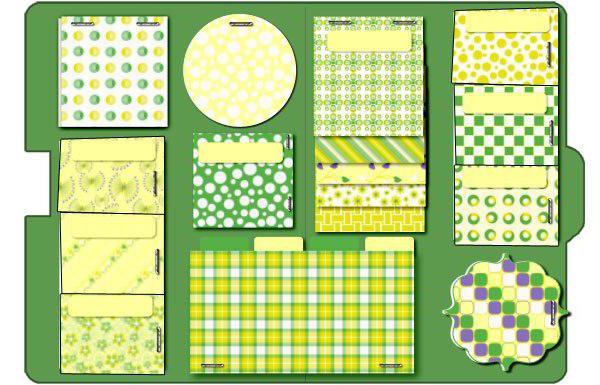
Many mothers doubt whether it is worth involving their child in working on a laptop or is it better to give him a ready-made folder as a surprise gift? It's up to you to decide, but as practice shows, absolutely all children love to make crafts using various techniques. And yes, even if the finished manual may not look ideal, its goal is to teach the child something new and captivate him for a long time. Therefore, if possible, be sure to make a lapbook not only for the child, but also with him. An interesting idea for those who decide to use printouts from a printer: choose black and white outline drawings that your daughter or son will color on their own. Try using various techniques to decorate your useful craft - let the lapbook be decorated with both applique and drawings. You can also glue not too voluminous decor inside, for example, fabric figures, flat buttons or sparkles.
How to work with a laptop?
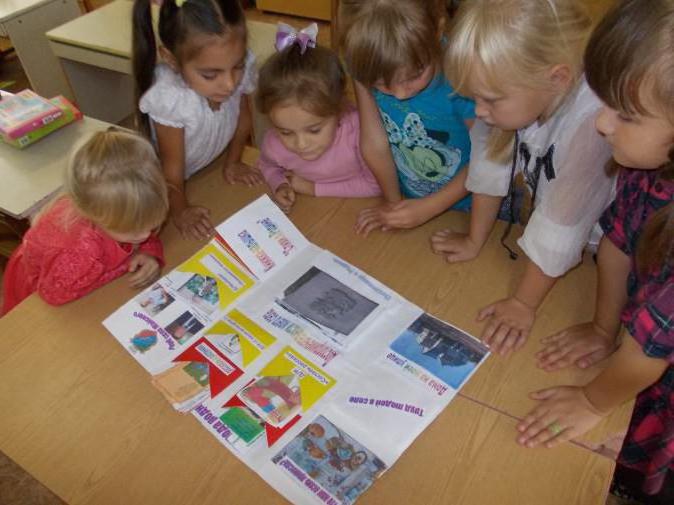
It is recommended to dry the fully completed educational folder for 24 hours, after which you can start practicing with it. A laptop for preschoolers is not only incredibly useful and interesting, but also universal. With such a folder, a child can study alone or with friends/siblings. You can simply examine the contents of the folder, revealing all the pockets and hidden pages, or you can complete all the tasks and repeat the given facts. And the best part is that a lapbook for preschoolers, made with your own hands, is truly individual; on its pages you can take into account and reflect all the interests of your own child. Considering the low cost of the craft and the speed of its production, try creating a home collection of educational folders about everything in the world, and in the future your child will definitely amaze you with his versatility and flexibility of thinking.
